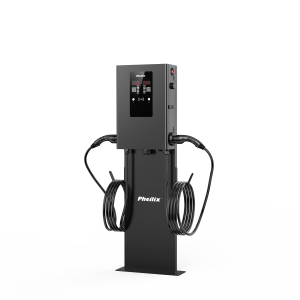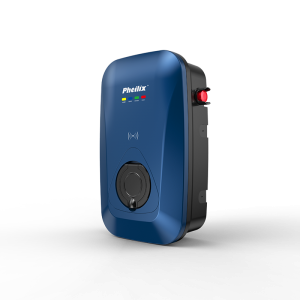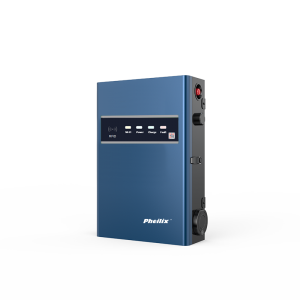-

Zero carbon system involves product
Smart EV Charging Solutions Pheilix offers a range of smart EV chargers designed for both residential and commercial use. Our chargers are equipped with advanced features like OCPP1.6 compatibility, app monitoring, and dynamic load balancing to ensure efficient and reliable charging experiences. OCPP1.6 Platform Integration Our OCPP1.6 platform is a robust solution for managing EV charging stations globally. It supports seamless integration with various EV chargers, providing real-tim... -

European EV charge point certified by CE and TUV
The OCPP1.6J management platform CE/TUV approved Commercial use EV Charger is designed for commercial use and is capable of charging electric vehicles with a maximum power output of 3.6 kW to 22 kW, depending on the model you choose. The charger is equipped with a single Type 2 Gun/socket, which is a popular type of connector used in Europe for electric vehicle charging.
-

DLB function of european ev charge point
The DLB function ensures that the available power across the EV charging point is automatically balanced, making sure that each vehicle gets a consistent and stable power supply. This means that even if two electric vehicles are charging simultaneously, the charging rate will not be affected, and the charging process will continue smoothly.
The Commercial use EV Charging station 2x22kw dual Guns/sockets is based on the OCPP1.6J open communication protocol. This protocol allows for secure and reliable communication between the charging station and the back-end management system. This means that users can remotely monitor and manage the charging points, check charging status and progress, and view and export charging records. Additionally, they can access real-time alerts and notifications, ensuring that any issues are quickly detected and resolved.
-

EU Standard EV Charge Point HomeSmart Wall Box 3.6kw,7.2Kw , 11Kw , 22kw
The Pheilix WallBox:EV HomeSmart is a smart charging wall unit which has been designed to provide the user with a simple, interactive EV charging solution for the home.This Smart system offers the EV driver full visibility and control over their EV charging activity. The EV driver can access their charge point via the app and gain access to remote switching as well as full analyitics of their charging session, including kWh consumption, electric miles, savings on CO2 emissions and even cost benefits against their previous petrol/diesel vehicle.
The EV driver can control the charging activity of their EV Chaging Point using their mobile phone or any other web enabled device, allowing them to monitor/record all their charging activity, data and history. Available with a Type 2, Mode 3 charging socket or tethered cable leads offering 3.6kw, 7.2kw, 11kw, 22kw charging speed.
As our customer, you can discuss EV charging on WhatsApp with us.
WhatsApp:+86 17317313367
-

Pheilix Ev Charger-Feature
Our company is a manufacturer of charging piles located in Shanghai, with a comprehensive product systemthat encompasses both hardware and Ocpp platforms (for CPOs) as well as an App for individual users to charge their vehicles.Our products range from AC to DC, covering both commercial and residential use.specifications of our commercial Ev chager as follow: -

Commercial 2x11kW dual sockets/Guns EV charging point
The 2x11kW dual sockets EV charger is a type of electric vehicle charging station that comes equipped with two charging ports or “guns” capable of delivering up to 11 kW of power each. This means that two electric vehicles can charge simultaneously from the same unit.
The 2x11kW dual socket EV charger is a popular choice for public and semi-public locations, as well as residential and commercial buildings. This type of charger is typically installed in locations such as car parks, shopping centers, airports, and other high traffic areas.
As our customer, you can discuss Charging station via WhatsApp with us.
WhatsApp:+86 13588999744
-

OCPP1.6j Commercial use EV Charger 2x11kw dual sockets with credit card payment and DLB (Dynamic loading balance ) function
In summary, the Pheilix 400VAC Commercial use EV Charger 2x11KW dual guns/sockets with credit card payment and DLB function and the OCPP1.6J cloud platform and App monitoring system provide a fast, efficient, and convenient charging experience for EV owners. These charging stations are ideal for use in commercial locations and public areas, and the DLB functionality ensures that the charging process is smooth and consistent. The monitoring system provides an easy way for operators to manage and monitor the charging points, while also ensuring that data is kept secure and private.
Electric vehicles are becoming more popular around the world due to their environmental benefits and the decreasing costs associated with them. To support the increasing demand, more and more commercial EV charging stations are being installed, catering to EV owners who need to top up their car’s battery while on the go.
One such type of Pheilix commercial EV charging station is the 400VAC (alternating current) charger that comes with 2x11kW dual guns or sockets. These EV chargers are designed to provide a fast and efficient charging experience for EV owners, and are ideal for use in locations such as commercial buildings, malls, and public parking areas.
As our customer, you can discuss EV charger on WhatsApp with us.
WhatsApp:+86 13588999744
-

U.K New regulation Home use OCPP1.6J 3.6kw/7.2 kW Wall box EV Charger APP monitoring
Pheilix Smart home electric vehicle charging point that is designed specifically for home use. It features OCPP1.6J, which is an open standard for electric vehicle charging communication. This allows for seamless communication between the electric vehicle and the charging station.
The EV CHARGER wall box is available in two power output options – 3.6kW and 7.2kW. The 3.6kW option is suitable for charging electric vehicles with a smaller battery capacity, while the 7.2kW option is suitable for charging electric vehicles with a larger battery capacity. -

Home use EV Charger 11kw/22kw wall mounted with Home load balancing and App monitoring function
Pheilix EV charger11KW/22KW WALL MOUNTED is compatible with all electric vehicle brands and models, making it a versatile choice for any EV owner. It is also waterproof and dustproof, so it can be safely installed both indoors and outdoors. This makes it a great option for those who may not have a garage or covered parking area.
-

OCPP1.6J managment Platform CE/TUV approved Commercial use EV Charger 400VAC 16A 11KW single Type 2 Gun/socket with wireless/credit card payment function
The OCPP1.6J management platform is an intelligent and modern communication protocol used for the convenient management and monitoring of electric vehicle charging stations. This protocol facilitates secure communication between the charging station and the backend management system, allowing businesses and organizations to effectively manage the charging process and obtain valuable data on EV usage.
The IEC61851/CE/TUV/OZEV approved commercial use EV charger is specifically designed for heavy-duty and commercial use cases. The charger is capable of delivering a maximum power output of 11kW with 400VAC 16A, making it one of the most powerful and efficient charging stations around. The charger comes with a single Type 2 Gun/socket, a standard connector used throughout Europe. This connector is versatile enough to handle both AC and DC charging and is widely accepted across the continent.
Moreover, the EV charging station comes equipped with a wireless/credit card payment function that can process payments via various electronic payment methods, including credit/debit cards, QR codes, and various mobile payment options. This payment flexibility provides customers with a convenient and secure payment method that saves them from the hassle of carrying cash.
The OCPP1.6J management platform EV Charger is compliant with various industry standards such as IEC61851, CE, TUV, and OZEV; this compliance ensures that the charger adheres to strict safety and quality standards. The station’s compliance with OZEV in the UK ensures that the station is eligible for government grants and subsidies.
-

OCPP1.6J managment Platform CE/TUV approved Commercial use EV Charger 400VAC 32A 22KW single Type 2 Gun/socket with wireless/credit card payment function
The OCPP1.6J management platform is an intelligent and open communication protocol used for the remote management and monitoring of electric vehicle charging stations. It allows for secure and reliable communication between the charging station and the backend management system. The OCPP1.6J protocol is widely used in EV charging stations across Europe and is one of the most popular protocols for EV charging.
The IEC61851/CE/TUV approved Commercial use EV Charger is designed for commercial use and is capable of delivering a maximum power output of 22 kW with 400VAC 32A. The charger is equipped with a single Type 2 Gun/socket, which is a common connector used in Europe for EV charging. The Type 2 connector is designed for both AC and DC charging and is widely accepted across Europe.
In addition to the Type 2 Gun/socket, the EV charging station comes with a wireless/credit card payment function, providing customers with a convenient and secure payment option. The payment process is simple and easy to use, and customers can pay for the charging services using their credit cards or by scanning a QR code.
The OCPP1.6J management platform EV Charger has been certified by IEC61851, CE, and TUV, which are recognized certification bodies for safety and quality standards. This certification ensures that the charger has been tested and approved to meet rigorous safety and quality standards.
The EV charging point is designed with advanced safety features, such as overvoltage protection, ground fault protection, and thermal protection, to ensure both the safety of the charger and the EV being charged. The station can detect any abnormalities during the charging process and can adjust the charging parameters to avoid damage to the vehicle or equipment. The charging station can also shut down automatically in the event of any safety issues.
-

Commercial use EV Charger 400VAC 63A 43kw Single Gun with 5m Type2 socket
Pheilix commercial use EV CHARGER 400VAC 63A 43kw rating refers to the amount of power the charger can deliver to your EV per hour. This high-capacity charger is ideal for commercial use where faster charging times are needed to optimize vehicle availability and reduce downtime. It can add significant range to electric and plug-in hybrid vehicles in a matter of minutes or hours, depending on the battery size and state of charge.
- Single gun design: The single gun design allows for one vehicle to charge at a time, which can be a good fit for smaller commercial fleets, such as taxis, delivery trucks, or private-use company cars. It simplifies the charging process and reduces the need for additional charging infrastructure.
- 5m Type2 socket: The Type2 socket is a standard plug type used in Europe for AC charging connections. It supports Mode 3 charging, which enables communication between the EV charger and the car to adjust the power level and monitor the charging status. The 5m length provides flexibility for parking and maneuvering the vehicle during charging.
- Commercial durability: Commercial-grade EV charging stations are built with rugged and durable materials to withstand heavy usage, outdoor exposure, and vandalism. They undergo rigorous testing and certification to ensure safety and reliability, and come with features such as overcurrent protection, ground fault detection, and surge suppression.
- Network connectivity: Commercial EV chargers are often part of a larger network that provides remote monitoring, control, and payment options. This allows facility managers or fleet operators to track usage, analyze data, and optimize charging schedules. Some networks also offer smart charging solutions that can balance the power demand among multiple chargers and other building loads to minimize energy costs and peak demand charges.
